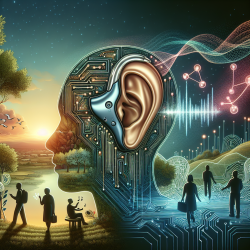Introduction
In the realm of audiology, the integration of technology has opened new avenues for enhancing patient care. The research article titled "Real-life and real-time hearing aid experiences: Insights from self-initiated ecological momentary assessments and natural language analysis" provides valuable insights into how real-time feedback from hearing aid users can be harnessed to improve clinical outcomes. This blog will delve into the findings of this study and explore how practitioners can leverage these insights to enhance their practice.
Understanding Ecological Momentary Assessment (EMA)
Ecological Momentary Assessment (EMA) is a method that allows individuals to report their experiences in real-time or shortly after they occur. This approach minimizes recall bias, providing more accurate and ecologically valid data. In the context of hearing aid users, EMA enables them to describe their experiences in their own words, free from the constraints of predefined survey jargon. This methodology can significantly enhance the clinician's ability to assess patient needs and tailor interventions accordingly.
Key Findings from the Study
The study conducted a cluster analysis on 8,793 open-text statements from 2,301 hearing aid users. The analysis revealed that approximately 60% of reports were related to speech intelligibility and sound quality in challenging situations, which were generally perceived positively. Conversely, about 40% of reports pertained to hearing aid management, which were often associated with negative experiences.
- Speech Intelligibility and Sound Quality: Users frequently reported positive experiences regarding speech intelligibility in challenging environments and the naturalness of sounds.
- Hearing Aid Management: Negative experiences were often related to issues with hearing aid management, such as battery life and connectivity problems.
Implications for Clinical Practice
For practitioners, the insights from this study underscore the importance of real-time feedback in tailoring hearing aid settings to individual needs. Here are some actionable strategies:
- Incorporate EMA in Routine Practice: Encourage patients to use smartphone apps to report their experiences in real-time. This data can provide invaluable insights for fine-tuning hearing aid settings.
- Focus on Personalized Care: Use the detailed feedback from EMAs to provide personalized counseling and interventions. Address specific issues such as sound quality and device management based on patient reports.
- Leverage Machine Learning: Large-scale EMA data can be used to train machine learning algorithms to predict and address user needs proactively, enhancing the overall user experience.
Encouraging Further Research
While the study provides a robust framework for integrating EMA into clinical practice, further research is needed to explore its full potential. Practitioners are encouraged to participate in research initiatives that aim to refine EMA methodologies and expand their applications in audiology.
Conclusion
The integration of EMA into audiological practice represents a significant step towards more responsive and personalized hearing care. By embracing these data-driven approaches, practitioners can enhance patient satisfaction and outcomes. To read the original research paper, please follow this link: Real-life and real-time hearing aid experiences: Insights from self-initiated ecological momentary assessments and natural language analysis.










